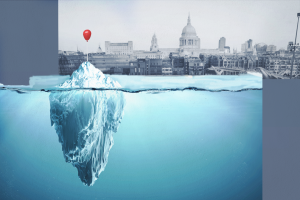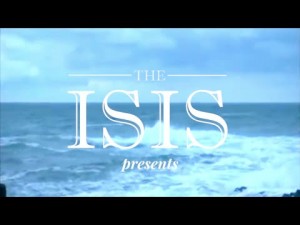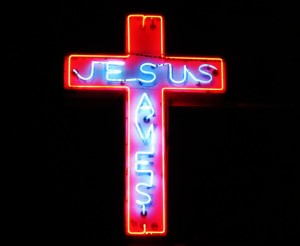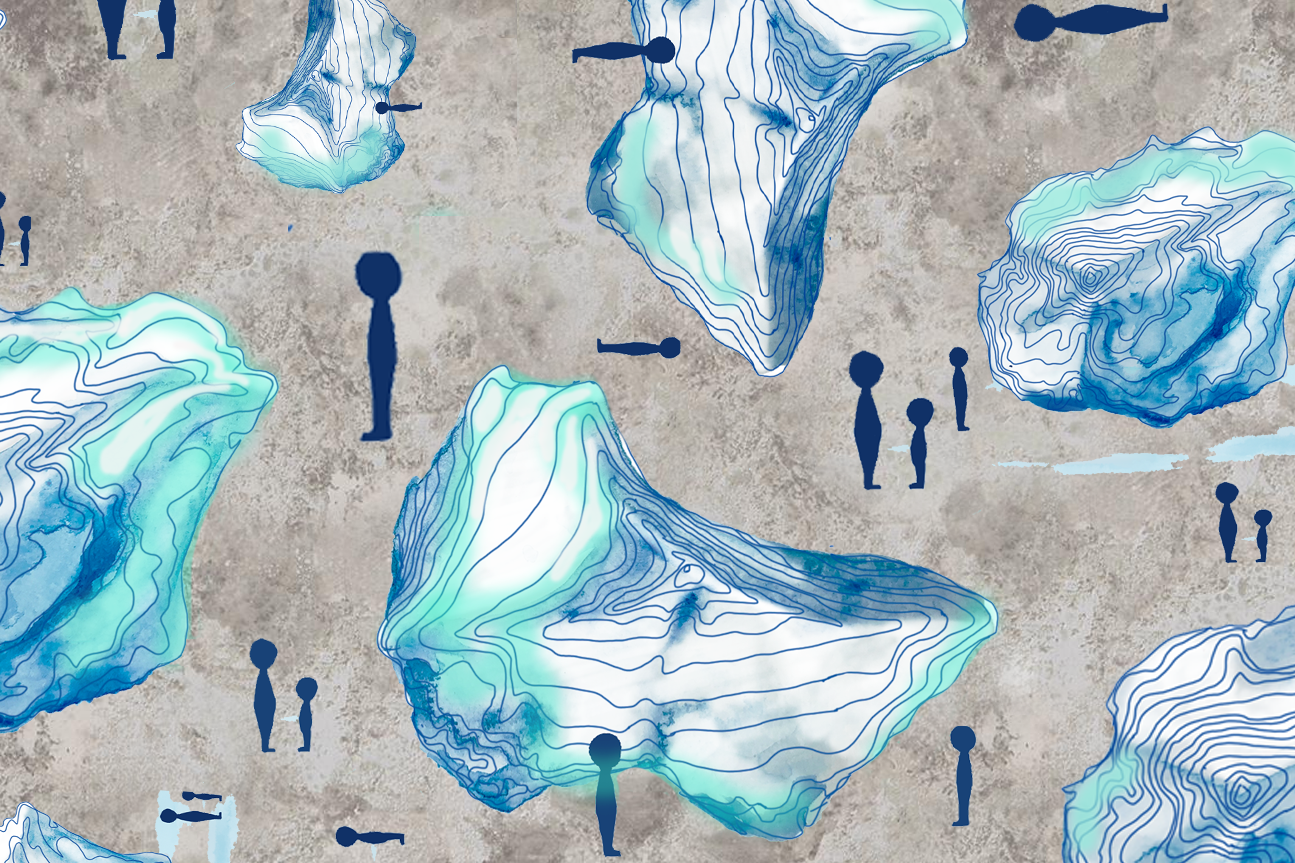
Part One: The Sixth Extinction
by Juni Ham | February 4, 2019
The twenty-four haphazardly arranged blocks of ice deposited on the wet grey tarmac outside the Tate Modern present a peculiar sight. Familiar, yet alien to this space, the gargantuan lumps encourage curious onlookers to engage in strange, even bizarre ways. Some maintain a careful physical distance from the ice-blocks, like hesitant dilettantes in a gallery, iPhones hovering avidly like vultures; some more audacious participants run their hands, even tongues, over the cold wet surface, as if to establish a mysterious bond with the foreign object. One woman glances sideward in case anyone is watching, then places her cheek hesitantly against the icy body, ear pressed to the white surface, as though trying to discern the sounds of the sea from the cavern of a giant mollusc shell.
The sight of this strange intimacy between the people and the ice is arresting. With the Thames running like muddy quicksilver in the background, you could almost imagine that the ice blocks were hauled from the water like hunks of gold out of a river somewhere east of California in ’49. But these blocks, fragments of an ice sheet from a Fjord in Greenland, may prove to be even more precious than that noble metal which caused the migration of hundreds of thousands of Americans to rivers in California a hundred and seventy years ago. These ice blocks are three-tonne lumps of physical evidence that we are running headlong into a global biological catastrophe, and they have been placed here so we can watch them melt. Fished out of the Nuup Kangerlua fjord by artist Olafur Eliasson and geologist Minik Rosing after being detached from the ice sheet, the icebergs were flown over to London for an exhibition, Ice Watch, at the Tate Modern on the eleventh of December. Ice Watch is hardly your usual Tate experience; the work will exist for only as long as the ice remains solid, a mere nine or so days. After this the work will – literally – evaporate into thin air.

In flying twenty-four blocks of ice across the globe, Eliasson and Rosing were attempting to overcome the distance which separates the perpetrator of climate change from the impacts of their actions. Scientists have confirmed countless times that we are slap-bang in the middle of a period of mass biological extinction due to climate change, yet governments worldwide show themselves stubbornly unwilling to introduce the policies needed to reduce Carbon Dioxide emissions. In a study published in July 2017 in the Proceedings of the National Academy of Sciences, scientists Ceballos, Ehrlich and Dirzo adopt an uncharacteristically desperate tone, referring to the loss of life as a “biological annihilation”. Clearly, desperation has become the only way forward in emphasizing what they term “the current magnitude of Earth’s ongoing sixth major extinction event”.
The Proceedings informs us that there have, thus far, been five mass extinctions during the history of life on this planet, events which led to a profound loss of biodiversity. The “mother of mass extinctions” occurred at the end of the Permian period, 250 million years ago, nearly wiping life entirely from the face of the earth. The most recent crisis took place at the close of the Cretaceous period. The planet’s biota – its dinosaurs, plesiosaurs, mosasaurs, ammonites, and pterosaurs – all but disappeared. It is shockingly little known that we are currently living through, and, according to the Proceedings, “well into”, a sixth extinction, one of “similarly catastrophic nature” which is seeing off the richest biota we have ever possessed. “Humanity needs to address anthropogenic population extirpation and decimation immediately” write Ceballos, Ehrlich and Dirzo. It is hard to imagine a more urgent plea from a scientific paper.
Most people are unaware – or choose to ignore – quite how catastrophic the extinction crisis our planet is currently undergoing really is. The alarm bells in the heads of the scientific community began to ring when the frogs started to die, and the story has hardly gone viral. A Scientific American headline from 2016 reads “THE RABBS TREE FROG JUST WENT EXTINCT”. Latest News articles streaming alongside catch the eye: “The Hippies Were Right! It’s all about Vibrations, Man!” or “Geologists Measure Bullet Damage to Ancient Middle Eastern Settlements”. One might be tempted to scroll right on past the obituary of this small brown amphibian – what place does a frog have, really, alongside the destruction of an ancient city? – if it weren’t for one line that stands out:
“The species has not been observed in the wild since 2007, just two years after it was first discovered by scientists”.
The line struck me as rather throw-away. It was presented as just another fact, strung curtly, even thoughtlessly, into a concatenation of them. Can it really be the case that a species has been wiped off the face of the planet just two years after it was first observed and documented by humans? Is it possible that amphibians are going extinct before we even have a chance to know they exist? And if this is indeed the case, why doesn’t it warrant more than 367 words in the Scientific American?
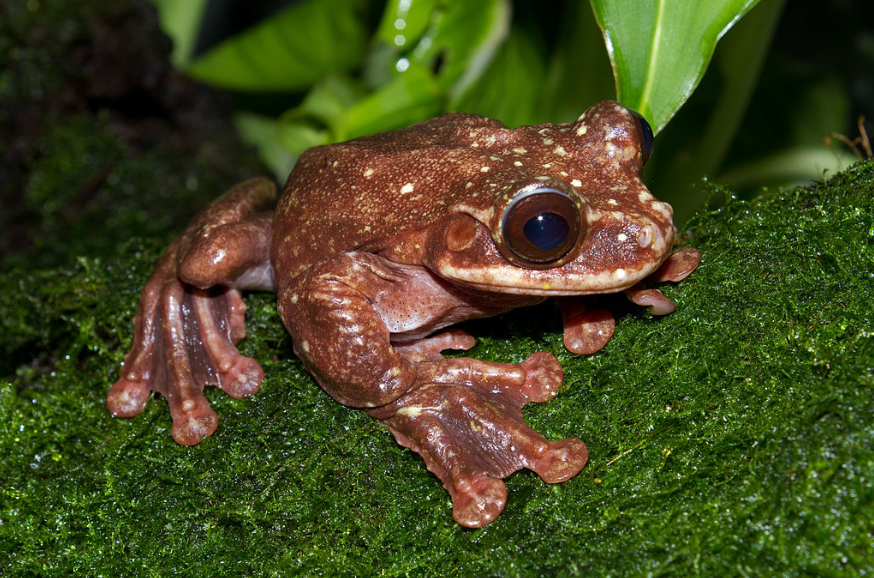
The more I read about it, the more catastrophic the death of this small brown amphibian begins to appear. Elizabeth Kolbert, in her book The Sixth Extinction, tells us the story of El Valle de Anton, a town situated in the epicentre of a volcanic crater in central Panama. The creek nearby was once nicknamed ‘Thousand Frog Stream’, due to the endless golden frogs visibly sunning themselves along the creek’s banks. By 2002, the frogs in the streams around Santa Fe, fifty miles west of El Valle, had all but disappeared. It was only in 2004 that biologists began to realize the gravity of the situation. By then it was already too late.
The Rabbs Tree frog presents a similar case. On the 26th of September 2016, the world’s last known example of the species was found dead at twelve years old in its enclosure in the Atlanta Botanical Garden. “Toughie” was likely the last of his kind on earth – and the Rabbs Tree frog is hardly just an ordinary example of its kind. In fact, they are (or were), the only known species where the tadpoles actually derive nutrition from feeding on the skin cells on the backs of their fathers. The implications of Toughie’s death, then, are more immense than we first imagined. Not only have we killed off an entire species, we’ve actually killed off the only known evolutionary example of a species which raises its young in this specific and unique fashion.
Guardian reporter Jeremy Hance was one of the few people to take note of this interesting lack of coverage. In his 2016 article, entitled “Frog Goes Extinct, Media Yawns”, he tells us of the presentation he delivered at a local herpetological society a week after Toughie’s death, in which he mentioned the species’ demise. “There were audible gasps in the room”, he writes. “Even herp lovers hadn’t heard of it”. According to Hance, platforms like the BBC, the Sun and CNN hadn’t even bothered the cover the story, which begs the question: how can the public possibly care, or even know, about global mass extinction, if the press refuses to even cover it? How can an Extinction Countdown column, plastered alongside The Hippies were Right! In the Scientific American, be enough to cover the disappearance of an entire species? “How can we care”, asks Hance, “if we don’t grieve?”
Current amphibian extinction rates could be as great as forty-five thousand times higher than background rates. Although a rigorous calculation of the background extinction rate for amphibians has not been performed – in part, because amphibian fossils are so rare – scientists are almost certain that the normal rate is lower than it is for mammals. It is estimated that one amphibian species should go extinct about every thousand years, meaning the chances that any one individual witness to such an event should really be zero. “Pretty much every herpetologist in the field has watched several” writes Kolbert. If the normal rate of amphibian extinction is lower than that of their egg-laying equivalents, what does this mean for mammals? Toughie’s death feels somewhat like a warning – one we are blatantly refusing to heed.
The word “extinction” carries destructive connotations, which is unsurprising, if we bear in mind the derivation of the word from the Latin “extinguo”, meaning “I quench, extinguish, or kill”. What is less discussed is the idea of extinctions as events of huge creative force in shaping the flow of life on earth, rather than as occasional interruptions. Many, such as Leakey and Lewin in The Sixth Extinction: Patterns of Life and the Future of Humankind, would even argue that extinction is at the very heart of evolution. Multicellular creatures, and most major animal phyla, first appeared in the fossil record during a period called the Cambrian explosion. This was arguably the most important evolutionary event in the history of life on the planet. Since then, it is estimated that some thirty billion species have populated the planet. Today, thirty million species roam the earth – meaning 99.9% of all species that have ever lived are, in fact, extinct. Statistically speaking, quipped David Raup in The Nemesis Affair, “all species that have ever lived are, to a first approximation, dead.”
Clearly, extinction is integral to evolution and to life. Five mass extinctions have occurred thus far in earth’s history, often nicknamed the “Big Five”. These consisted of biological crises in which at least 65% of all species became extinct in a brief geological instant. Each crisis was followed by a dramatic shift in the character of ecological communities – which is interesting, because it implies that extinction events do not only have the power to extinguish life, but also to create it. The end-cretaceous event sixty-five million years ago oversaw the demise of 140 million years of terrestrial rule by dinosaurs. In the Cenozoic era which followed, mammals replaced them as the rulers of the land.
What is different now is the cause of global extinction. According to palaeontologist Steven Stanley at The Johns Hopkins University, changing climate is “the most important cause of crises in the history of life”. But it usually takes thousands of years for the earth’s climate to change noticeably. The closest scenario to ours was an episode known as the Paleo-Eocene Thermal Maximum around fifty-five million years ago, where the average global temperature rose by 5-8° in a just few thousand years. This is far slower than our current rate of global warming. And one result is a radical increase in extinction rates. Current extinction rates are actually running at a thousand to ten thousand times higher than background extinction – unquestionably qualifying the Anthropocene as another period of mass extinction. The reality is absolutely catastrophic, and it is all around us. We are causing a mass extinction event, the cataclysmic magnitude of which has not occurred for half a billion years. But to face up to our actions would involve a horrifying degree of self-scrutiny.
The climate drive, writes Time editor Jeffrey Kluger, “lacks the absolutely critical component—the “me” component”. “Nobody wakes up in the morning and looks at the long-term climate forecast. They ask what the weather is today, where I live, and how it’s going to affect me.” We tend to discount risk if we perceive it as far enough in the future and focus instead on immediate concerns. Even, notes Kluger, when the risk isn’t that far in the future, people will still find an excuse not to act. When governments issues hurricane warnings, many stay on the couch. This is what’s known as an “optimism bias”: this is a cognitive bias that makes people believe they are at lesser risk of experiencing a negative event compared to others. Why do smokers start smoking, in spite of the “Smoking Kills” warnings on their packs of cigarettes?
Kluger also cites a sense of futility as one of the causes for our blasé attitude towards climate change. If our future is indeed as “catastrophic” as we are being told, individual action begins to seem pointless in comparison. Risk experts call this the inefficiency factor. How can individual actions alone curtail something as vast as mass extinction or global climate change? Ice Watch is one example of a valiant attempt by the artistic community to bring climate change closer to home, but are events like these enough to change the way people think and act? ∎
Words by Juni Ham. Illustrations by Julia Jones and Juni Ham.
